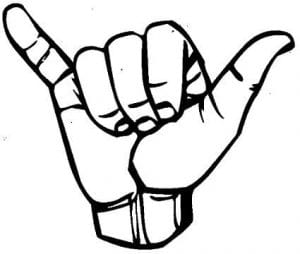Title: Shaka
General Information about Item:
- Genre: Gesture
- Place Collected: Dartmouth College, Hanover NH, USA
- Date Collected: November 7th, 2019
- Country of Origin: Hawaii, US
- Informant: Albert Austin
Informant Data:
- Albert Austin is a male student at Dartmouth College in the class of 2020. He was born in Baltimore, MD, and raised just outside of Philadelphia, PA. He spends most of his year in Hanover, NH at Dartmouth but resides in Hingham, MA in the off terms and over break.
Contextual Data:
- Social Context: Albert learned this hand gesture from his uncle and from various Hollywood movies. His uncle is from San Francisco, CA and is an avid surfer and sailor. The hand gesture to him means something like “hangout” or “hey man”. He said it was difficult to describe exactly when the Shaka is used, but he does know it is a part of Hawaiian culture. The way Albert learned to use the gesture is in situations when one is clarifying if everything is okay with someone else or if one is happy and having fun. He has also seen it as a way to instruct peace in times of tension, using the gesture as a way to say “I mean no harm are we all good here?”.
- Cultural Context: Hawaii is a group of volcanic islands located in the Pacific Ocean. The population of Hawaii is around 1,300,000 people. The islands were annexed by the US in 1900, and soon after the population steadily increased. Plantations for sugar can and pineapples were established. One of the islands was attacked in 1941 by Japnese fighter planes, propelling the US into WW2. Soon after, Hawaii became the 50th state in 1959. After researching a bit, this gesture seems to have been created around the early 1900s. Supposedly, there was a man who worked at a sugar mill, and his job was to feed cane through the rollers to squeeze out its juice. One day, this man’s hands got stuck in the rollers, and his middle 3 fingers were crushed. After that, he became the security guard for the train, and he had to prevent rebellious children from jumping on the train. If he saw the kids trying to get on the train, he would shout and wave his hands to get their attention and to tell them to stop. The kids adopted and remade that gesture- it was readapted to be the sign to indicate that the guard was not around and that they could jump on the train. Hence the now positive connotation of “let’s hangout” or “we’re good to go!”
Item:
- This hand gesture often involves a slightly bent elbow and begins with the palm facing out. The three middle fingers are bent while the pinky and thumb are pointed straight out (ex. If doing the shaka with the right hand, the pinky points out to the right and the thumb points out to the left). The fingers and arm are held in the same position as the hand is rotated from the left to the right, as to shake the Shaka.
Collector’s Comments (Interpretation): We think that this holds significance for the group that carries out this folklore because the story that it seems to be adapted from took place in Hawaii, and revolved around sugar mills, which is what Hawaii was known for when the islands were first populated. Also, we think that since this kids used it as a sign of positive affirmation, it’s a fun way to signal that everything is okay, so we think it was easily spread and accepted as a way to say that everything sounds good. Lastly, we think people in Hawaii may generally just want to be as optimistic as possible, so use this as a fun way to signal that everything will be alright.
Collector’s Name: Bailey Burke and Avery Vanacore
Tags/Keywords:
- Hand gesture
- Hawaii
- Shaka
- Positive

